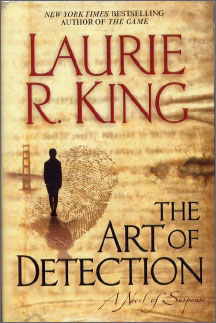 |
 Laurie R. King
Laurie R. King
The Art of Detection
Reviewed by: Rick Kleffel © 2006
Bantam / Random House
US First Edition Hardcover
ISBN 0-553-80453-7
Publication Date: 05-30-2006
358 Pages; $24
Date Reviewed: 06-23-06
Index:
Mystery
General Fiction
Detective Kate Martinelli steps out of modern-day San Francisco and into a Victorian sitting room on page one of Laurie R. King's 'The Art of Detection'. This is not some cheesy time-travel device. Martinelli has been called to the scene of a murder most Victorian. She's investigating the death of a Sherlock Holmes fanatic, a man who did not just read the books, but lived the life of the Great Detective. Given that King is the author of the phenomenally successful Mary Russell/Sherlock Holmes series, Kate Martinelli won't be the only one who finds the setup suspicious. The mystery is not limited to the murder of Philip Gilbert. The real mystery is whether or not King will be able to successfully merge her series based on two characters separated not just by a stretch of some seventy years, but by the gulf between "fact" and "fiction".
King's mix is by and large successful and certainly surprising. The challenge she faces seems insurmountable. How to combine the closely-observed, carefully written present-day police procedurals starring Kate Martinelli with the broader historical pastiches of Mary Russell? King's ingenious solution puts Martinelli in pursuit of what might be a lost Holmes manuscript, worth a fair chunk of change. Have no doubt. That manuscript will be revealed, every word, as Martinelli pursues her perpetrator in the present. And within that manuscript, another mystery unfolds, also set in San Francisco, but not of the present. Indeed, the unnamed narrator of manuscript is a man of a very certain disposition and a certain kind of talent, at loose ends in San Francisco shortly after the events of 'Locked Rooms'. Is the manuscript real or fake? Is the author the great Arthur Conan Doyle, or another Great? Just where does the fiction end and real world begin?
For those of us just joining the Kate Martinelli books, you'll find a low-key, well written mystery with a serious sense of character, place and time. Present day San Francisco is beautifully evoked. One of the pleasures of the police procedural is the manner in which the author envelopes the reader in a very specific setting. King's descriptions of San Francisco are evocative and atmospheric, but sparse enough to keep the characters in the foreground. It's a delicate balance that King handles extraordinarily well. Martinelli's home life is revealed in nicely nuanced scenes of domestic, well not exactly bliss, but happiness, to be sure. She's a lesbian with a life partner and a child. The prickly road that they must travel is not one filled with daisies and roses, but potholes and speed bumps. But King creates the feel of a real relationship by using the same low-key approach to the domestic side as she does for the mystery.
The mystery of Philip Gilbert's murder gives King the opportunity to have some fun with her own contribution to world of Sherlockiana. The victim is a rabid Holmes fan, with a boatload of money and a compulsive personality. He's found dead in a scenic location. The only people who knew him are his fellow fans. The "who done it" aspect of 'The Art of Detection' will require more art than detection, and King is up to that challenge. But the maguffin— and here's a term that both Conan Doyle and Sherlock Holmes would have loved— is the lost Holmes manuscript. And we get that manuscript, a Holmes novella, essentially in pretty much one undigested chunk in the center of the novel as a whole.
For this reader, the story-within-the-story was the highlight of the novel. It’s a beautifully turned bit of historical fiction. While it certainly makes every indication that the narrator is Holmes himself, no name is ever offered. Indeed, it need not be a Holmes story. It does not feed off that myth, really, at all. It's just a rollicking murder mystery set amidst a much wilder San Francisco. The mystery in the manuscript, however, itself offers a clue for the current-day mystery that Martinelli is trying to solve. And the themes of both stories act as a sort of historical hall of mirrors.
How satisfying this will be to readers of the various series is bound to vary quite a bit from reader to reader. This reader enjoyed the Martinelli segments enough to want to go back and start from the beginning. That said, there's no requirement to do so in order to enjoy the present-day story. However, the historical novella within was equally enjoyable and by virtue of being condensed, seemed more powerful. There's no getting around a comparison, and the historical segment is clearly the chocolate nougat at the center of this clever confection.
Of great interest to this reader is the question of which reality this novel inhabits. On one hand, we have Sherlock Holmes clearly established as a fictional character. On the other hand, we have the historical narrator whom the reader knows to be "the real Sherlock Holmes". Within King's fiction, the Holmes character has more than once commented about being mistaken for a fictional character. There's quite a bit of delight to be found in this surreptitiously surreal mix of the real, the unreal, and the really unreal. And of course, should you be so inclined, you can just ignore that whole aspect and enjoy not one, but two good mysteries between one set of covers.
|
 |
